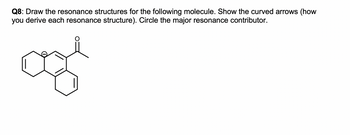
Organic Chemistry: A Guided Inquiry
2nd Edition
ISBN: 9780618974122
Author: Andrei Straumanis
Publisher: Cengage Learning
expand_more
expand_more
format_list_bulleted
Question

Transcribed Image Text:Q8: Draw the resonance structures for the following molecule. Show the curved arrows (how
you derive each resonance structure). Circle the major resonance contributor.
Expert Solution
This question has been solved!
Explore an expertly crafted, step-by-step solution for a thorough understanding of key concepts.
Step by stepSolved in 2 steps with 6 images

Knowledge Booster
Similar questions
- For each proposed set of resonance structures: a. (E) Add curved arrows (starting from left) to show how each successive r.s. was generated. b. Cross out any resonance structures that are NOT important, and explain your reasoning.arrow_forwardQ8: Draw the resonance structures for the following molecule. Show the curved arrows (how you derive each resonance structure). Circle the major resonance contributor. одarrow_forwardIn part 1 adding the missing curved arrow notation.In part 2 draw the structure resulting from the given curved arrow notation.arrow_forward
- Please provide explanationarrow_forwardAdd curved arrows to show how the first resonance structure can be converted into the second.arrow_forwardFor the following, use curved arrows to show the transformation of one resonance structure into another. Label the major and minor resonance forms (major and minor contributors to the resonance hybrid), and show which ones are of equal energy. Briefly justify your choices. Draw the structure of the resonance hybrid. [re % la] uarrow_forward
- For the following Structure, a) draw in any missing lone pairs; b) identify and list the resonance patterns (i.e. allylic cation) present. If one pattern shows up more than once, list it multiple times c) draw curved arrows on the initial structure to produce a resonance structure, including formal charge. (hint - use a minimum of curved arrows for each resonance structure). Repeat on the second structure to generate a third structure. Rank the resonance structures in order of decreasing importance: 1 is most important, 2 is second most important, etc... H Pattern 1: Pattern 2: Rank: Pattern 1: Pattern 2: Rank: Pattern 1: Pattern 2: Rank:arrow_forward4. Draw the possible resonance structures for compounds C and D. Include lone pairs and indicate non-zero formal charges. Circle the minor resonance contributor for compound C. O :O: :O: C & Darrow_forwardDraw a resonance structure that results from the arrow pushing scheme below. Make sure to include the positive negative charges.arrow_forward
- Please draw the arrow formalism on the 1st structure (top) that accounts for the 2nd resonance structure (bottom).arrow_forward4. Circle the following pairs of structures that do not constitute resonance structures. For the proper resonance pairs, draw curved arrows to convert the first structure to the second. Draw in all lone pairs of electrons. H3C-CH3 „CH3 HgC-N' a) b) H2C=C=CH2 H3C-CECH FCH2 d) H3C' CH2 H H3Carrow_forward3. Draw all resonance structures for the following radicals.arrow_forward
arrow_back_ios
SEE MORE QUESTIONS
arrow_forward_ios
Recommended textbooks for you
 Organic Chemistry: A Guided InquiryChemistryISBN:9780618974122Author:Andrei StraumanisPublisher:Cengage Learning
Organic Chemistry: A Guided InquiryChemistryISBN:9780618974122Author:Andrei StraumanisPublisher:Cengage Learning

Organic Chemistry: A Guided Inquiry
Chemistry
ISBN:9780618974122
Author:Andrei Straumanis
Publisher:Cengage Learning
